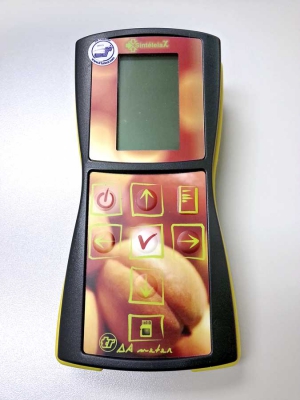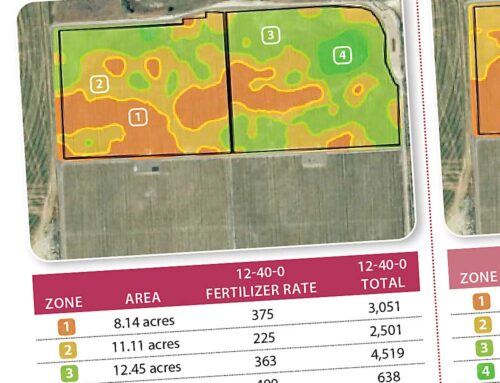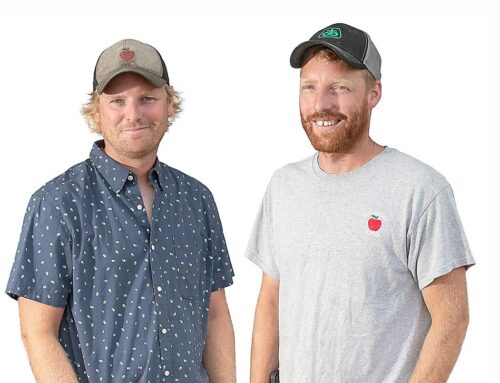
(Geraldine Warner/Good Fruit Grower)
If you’re tired of spilled iodine and starch conversion patterns that are difficult to interpret, there’s an easier way to assess fruit maturity.
A battery-operated, handheld device called the DA-meter, which was developed in Italy, allows growers to nondestructively monitor fruit ripening on the tree so they can pick the crop at the optimum time.
Larry Lutz, vice president of agricultural services with Scotian Gold in Coldbrook, Nova Scotia, Canada, said that in the past the cooperative used what he calls the “dreaded starch iodine test” to assess fruit maturity. Apples are cut in half and the cut areas are soaked in an iodine solution.
Starchy (immature) areas of the fruit will turn a blue-black color, while parts of the apple where the starch has converted into sugars will be clear.
Lutz decided there had to be a better way. Besides being destructive, the starch-iodine test is very subjective and it takes experience to interpret the results. Another complication is that there is more than one starch scale to compare the results to.
In contrast, taking readings with the DA-meter is quick and simple, Lutz said, and the device is easy to calibrate for different varieties.
In recent years, Scotian Gold has been using the DA-meter in place of starch–iodine tests to monitor maturity of Honeycrisp and SweeTango apples.
Honey-crisp is the number-one variety in Nova Scotia, and harvesting at the right time is critical, he said, because fruit picked too early tends to develop high levels of bitter pit in storage, while fruit picked too late develops soggy breakdown and internal browning.
“You have to know when to pick the fruit,” he said. “It has to be picked at the right time to get it out of storage and on the shelf in decent shape. Honeycrisp has to be picked when it wants to be picked and not when you get around to doing it.”
Traditionally, Honeycrisp apples are picked when they have 75 to 80 percent bright red color and the background is turning from green to straw color. However, because of the warm summer days and cool nights in Nova Scotia, it’s not uncommon to have apples with 80 to 85 percent good red color that are still immature inside. Some Honey-crisp apples mature without gaining enough color.
How it works
Dr. Stefano Musacchi, pomologist at Washington State University, said the DA-meter shines beams of light on the apple and the reading is based on the amount of light reemitted by the fruit. The device actually measures the chlorophyll in the mesocarp of the fruit, about three millimeters below the skin.
The readings, which decline in value as the fruit ripens and the chlorophyll degrades, are thought to be correlated with ethylene production.
Dr. John Delong, postharvest physiologist with Agriculture and Agri-Food Canada at Kentville, Nova Scotia, who introduced the company to the DA–meter, has worked for three years to identify the appropriate readings for growers to use. The recommendation now is that growers start picking fruit for long-term storage at a DA-meter index of 0.60.
When the index reaches 0.35, fruit should be picked for short-term storage only. Lutz said these numbers are specific to Nova Scotia and are not recommended for other areas.
Musacchi said the DA-meter can also be used at the packing house to classify fruit by maturity so it can be stored appropriately. It can also be used by retailers to determine which fruit needs to be sold first.
The DA-meter was developed initially as a research tool to assess peach maturity by Dr. Guglielmo Costa at the University of Bologna. It works well for pears as well as apples. It has two gigabytes of memory and a USB port enabling the data to be downloaded to a computer.
Manufactured by Sintélleia, it is available from the Italian company T.R. Turoni. For information, check the website at www.trturoni.com/en/.
Lutz and Musacchi spoke during the annual meeting of the International Fruit Tree Association in Kelowna, British Columbia, in February.






Dr. E. Kupferman noted that apple quality and maturity must be monitored throughout the storage duration to assure that apples of the highest quality reach the marketplace. (Excerpt from Delicious Harvest Maturity and Storage, 2010, WSU Postharvest Information Network webpage.)